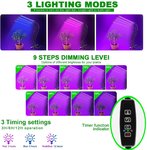thanks for the research and info.
do you think the above posted pics and linked LED im eyeing down is somewhat effective, not useless, and worth $29 to my door? would the combo purple or blue make the most sense for my 4-6 hours in evening with it on be the setting to run? as i said, im only looking for a decent, supplemental, addition for my plants health to carry thru winter.
thanks, you seem smaht (im from near bostahn)
also, i have succulents in addition to plants i mentioned, and the multi thousand reviews with 5 stars i find very compelling, generally. high value ratio with reviews.








